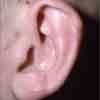An 18-Year-Old Man With Itchy Ears
For several weeks, an 18-year-old man has been bothered by itchy ears. He has seasonal allergies that are well controlled with oral antihistamines. He has not been exposed to contactants and has not used any nutritional supplements or new shampoos or conditioners. He works out at a gym 5 days a week.
Case 1: Why does this man's ear itch?
For several weeks, an 18-year-old man has been bothered by itchy ears. He has seasonal allergies that are well controlled with oral antihistamines. He has not been exposed to contactants and has not used any nutritional supplements or new shampoos or conditioners. He works out at a gym 5 days a week.
Which of the following do you suspect?

A. Relapsing polychondritis.
B. Atopic dermatitis.
C. Seborrheic dermatitis.
D. Psoriasis.
E. Contact dermatitis.

Case 1:
This patient had a flare of atopic dermatitis, B. A mid-potency topical corticosteroid helped relieve the symptoms. No obvious cause was identified.
Relapsing polychondritis is typically painful, not pruritic. Seborrheic dermatitis and psoriasis usually involve the external auditory canal and the area behind the ears. Contact dermatitis may be ruled out because there was no exposure history.
Case 2:
For several weeks, a 10-year-old boy's feet have been scaly and pruritic. He plays basketball and soccer and recently bought new shoes. A trial of over-the-counter miconazole was ineffective. The patient has a history of childhood eczema but outgrew it about 5 years ago.
What might explain the boy's symptoms?

A. Contact dermatitis to new shoes.
B. Juvenile plantar dermatitis.
C. Tinea pedis.
D. Psoriasis.
E. Keratoderma.

Case 2:
The triad of sweaty feet, occlusive footwear, and a history of eczema suggests juvenile plantar dermatitis, B. Symptoms can be controlled if patients keep their feet dry by using foot powder and changing socks frequently. Topical corticosteroids or topical immunomodulators, such as tacrolimus and pimecrolimus, are also effective. Juvenile plantar dermatitis typically improves at puberty.
Contact dermatitis to shoes usually manifests on the dorsa of the feet. Tinea pedis is usually scalier and, unlike juvenile plantar dermatitis, involves the toe webs. Psoriasis is unlikely to involve just the soles and features more erythema and scale. Keratoderma is characterized by a thickened layer that produces a waxy appearance.
Case 3:
A 10-year-old boy has noticed asymptomatic discoloration on his back this summer. He has mild seasonal allergies that are controlled with over-the-counter medications. He plays soccer and has been swimming in a pool. He has had a dog and a cat for the past 2 years.
Which of the conditions in the differential is the likely diagnosis?

A. Vitiligo.
B. Pityriasis alba.
C. Tinea versicolor.
D. Tinea corporis.
E. Pityriasis rosea.

Case 3:
This patient has pityriasis alba, B, a postinflammatory hypopigmentation associated with chronic eczema; it interferes with normal tanning. The patient was advised to change his bathing routine (no washcloth, lukewarm water, no antibacterial soaps, avoid washing rash) and to apply a moisturizer, sunscreen, and a low-potency topical corticosteroid.His skin color evened out during the next 4 to 6 weeks.
Vitiligo consists of permanent depigmentation, not reversible hypopigmentation. Tinea versicolor, tinea corporis, and pityriasis rosea all feature scaling, and the latter 2 are usually pruritic.
Recognize & Refer: Hemangiomas in pediatrics
July 17th 2019Contemporary Pediatrics sits down exclusively with Sheila Fallon Friedlander, MD, a professor dermatology and pediatrics, to discuss the one key condition for which she believes community pediatricians should be especially aware-hemangiomas.